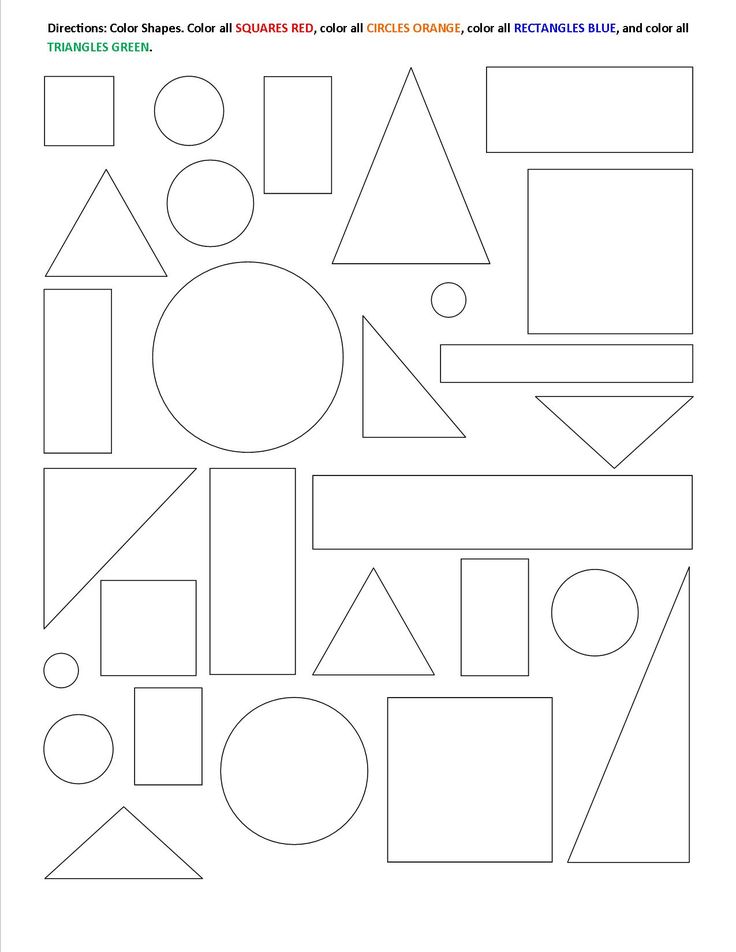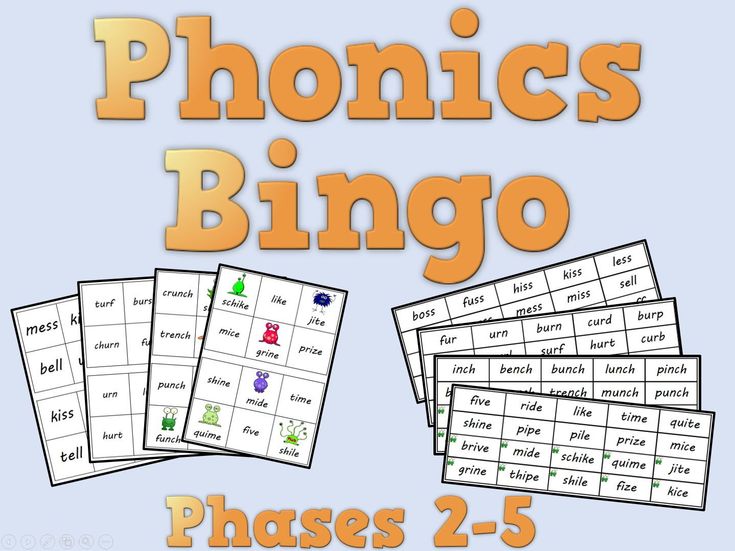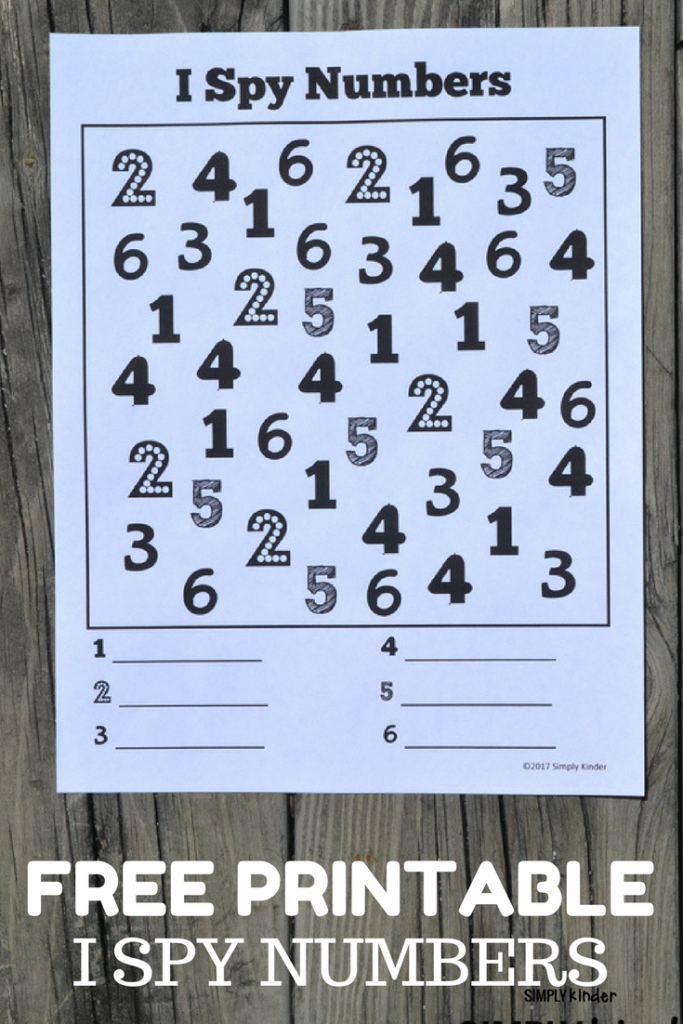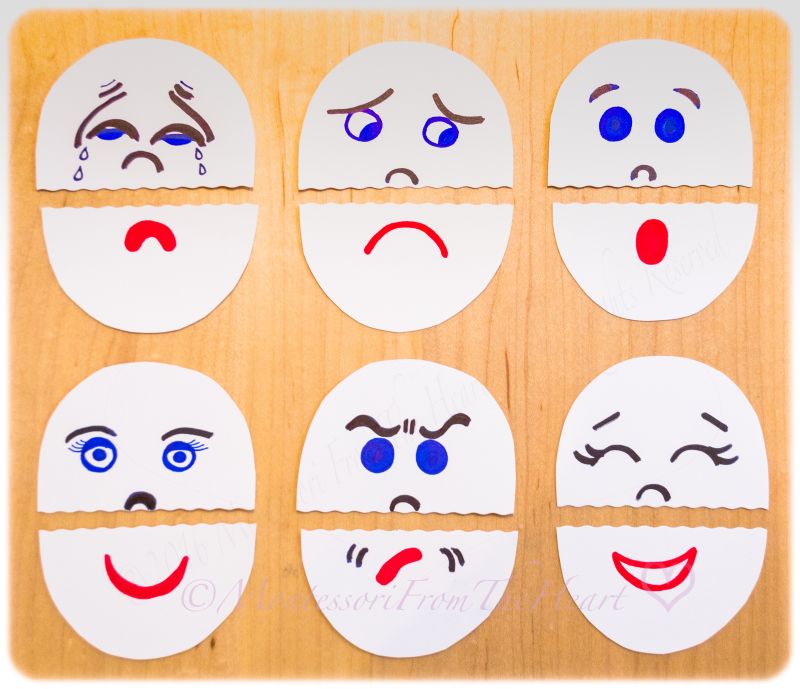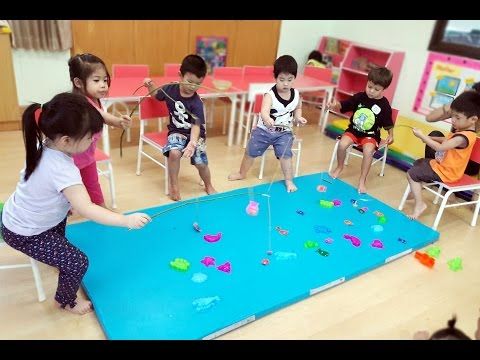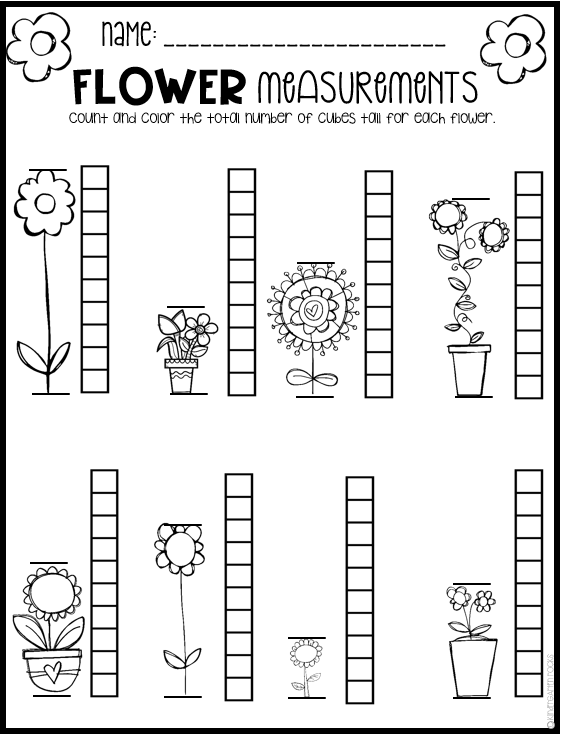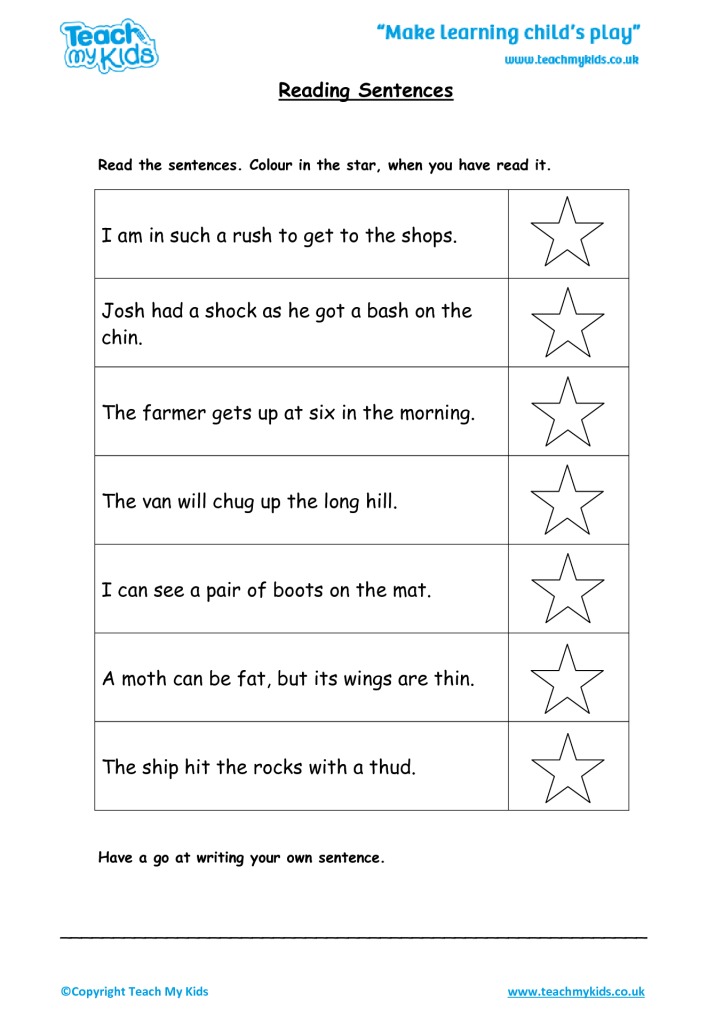Teaching shapes to kindergarten
Fun and Engaging 2D Shape Activities
One of the very first math lessons we teach in kindergarten is two-dimensional shapes! There are so many ways you can introduce shapes while also engaging your students in fun, hands-on activities. I think one of my favorite things about teaching shapes is that the students don’t even realize they are learning! They get to build, sort, and manipulate shapes in many ways, which leads to high engagement. Read on for my favorite kindergarten-approved 2D shape activities that your students will love!
Activities for Teaching 2D Shapes
Since shapes are all around us, chances are that many of our students will enter kindergarten with a basic knowledge of shape names. It also doesn’t take too long to fill in the missing shape names that our students haven’t quite mastered. After that, the goal is for our students to describe, build, and even manipulate two-dimensional shapes. This is where some additional shape practice activities can come in handy!
Introducing Shape Names and Attributes
The first step in teaching students shapes is to make sure they know all of the 2D shape names and their unique attributes. I have found that all students benefit from an introduction (or reintroduction) to the shape names and attributes before we move on to other 2D shape activities.
I love introducing and reviewing shapes with these 2D Shapes Poems! These poems are catchy and help students learn about each shape’s attributes as well as relate them to real-world objects that they already know. Before you know it, your students will look at a stop sign and say, “Hey, that’s an octagon!” 🙂 #proudteachermoment
I introduce the shapes one at a time which prevents overwhelm and allows the students to focus on that shape and its unique attributes. We practice one shape each day until all of them have been added to our shape wall!
Identifying and Describing Shapes
After plenty of time has been spent pronouncing the shape names and discussing the shape attributes, it is time for students to put that knowledge into practice. They are now ready to identify shapes in different contexts and describe them in their own words! As with any new concept, it’s important to keep young learners engaged by using a variety of activities when practicing the same skill multiple times, such as identifying and describing shapes.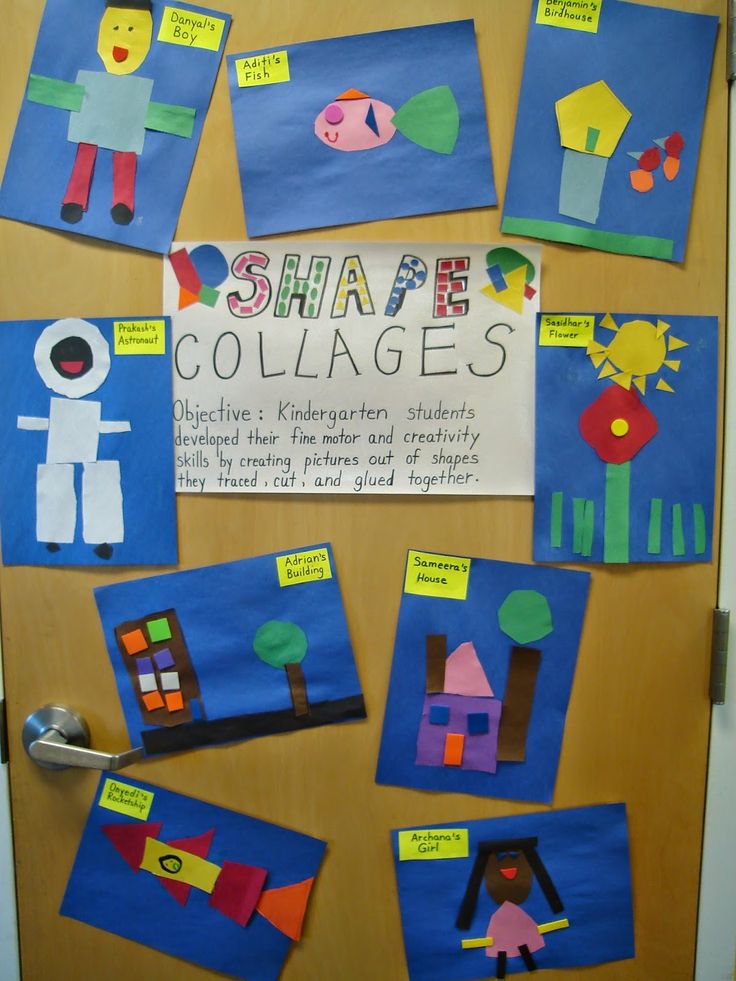
Shape Bingo is a fun way to add repetition to your 2D shape practice because students will want to play this game over and over again! I love to play this game in small groups, so we can quickly review the shape names and attributes as we draw each card. For an added challenge, you could pull a card and keep it hidden from the students. Then, give them clues about the shape by describing its unique attributes so that the students can guess the correct shape before placing their bingo markers.
I also love to encourage students to identify shapes in the world around them. One way to practice this skill is with a shape sort, where students can identify and sort a variety of real-world objects based on shape. This 2D shape sort is a very fun center activity that gets students excited to look for shapes all around them. It’s so fun to hear students point out the shapes they see as they walk down the hall!
Here are several more 2D shape activity ideas that will keep your students engaged as they practice identifying and describing shapes in multiple ways:
- Play a shape game where students draw a shape out of a bucket and say its name and whether it has curved or straight lines
- Play “I Spy” where students must find real-world objects that match a specific shape
- Go outside on a nature hunt and see what you can find in each shape
- Do a shape show-and-tell
Making Shapes
After students have a good understanding of shape names and their attributes, they are ready to start building shapes on their own! There are many ways to provide individualized opportunities for shape building, based on the fine motor skills of your students.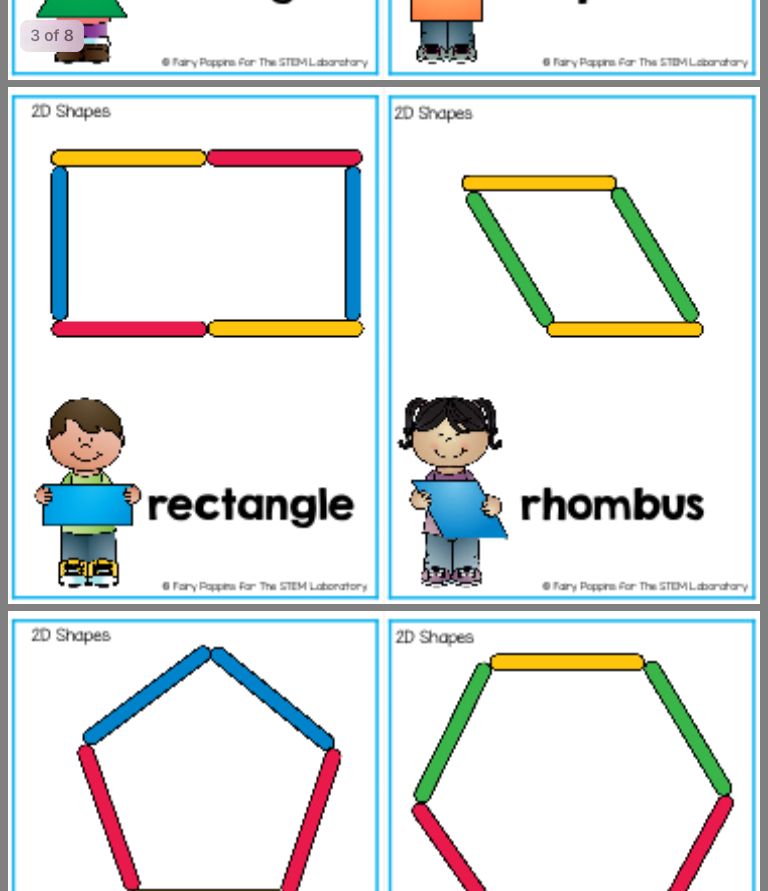 Some students might form shapes using craft sticks while other students might be ready to trace shapes with a highlighter.
Some students might form shapes using craft sticks while other students might be ready to trace shapes with a highlighter.
In the kindergarten classroom, it’s important to include fine motor practice anywhere we can. Two-dimensional shape building practice is the perfect time to strengthen hand-eye coordination and writing skills! Here are some additional ways to practice forming and writing shapes:
- Practice drawing shapes in the air
- Highlight shapes
- Trace shapes with a writing utensil
- Practice making shapes with sensory materials, such as in sensory trays filled with beads, cereal, rice, etc.
- Trace over shapes with little cars or something similar
- Form shapes with playdough (Check out this playdough mat freebie)
- Form shapes with craft supplies, such as pom-poms, craft sticks, pipe cleaners, etc.
Working With Shapes
Once students have had plenty of time to form shapes using their knowledge of shape names and attributes, they’re ready for the next step: Working with shapes.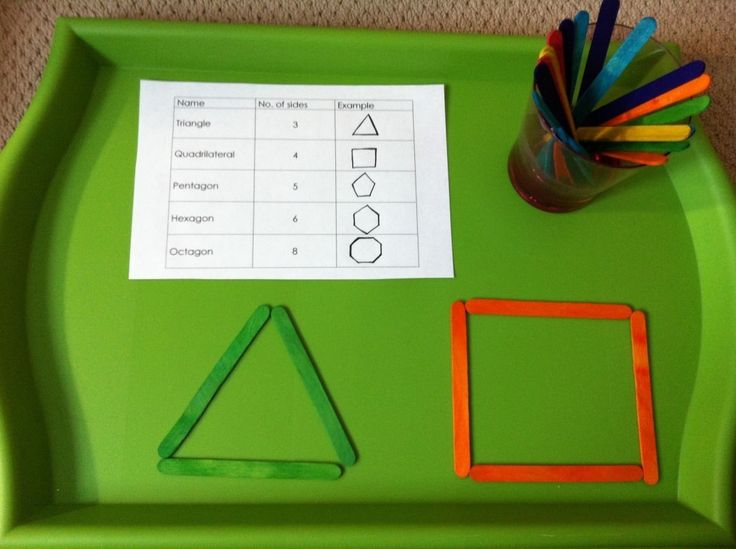
When students are given plenty of opportunities to manipulate and work with shapes in various ways, it deepens their understanding of two-dimensional shapes and prepares them for future math concepts.
One of my favorite 2D shape activities is this shape-building activity, where students can see the relationship between shapes as they use pattern blocks to create a larger shape. I love how this activity encourages students to see how shapes are related to each other.
Here are some of my other favorite ways to help students build on their budding knowledge of 2D shapes:
- Sort shapes by attributes, size, color, etc.
- Build with shapes
- See what they can build using only one shape
- Do art projects using a variety of shapes
- Build their name with shapes
- Make a shape book
Using 2D Shape Activities for Centers
Many of the activities I mentioned above would be perfect for math centers in your kindergarten classroom.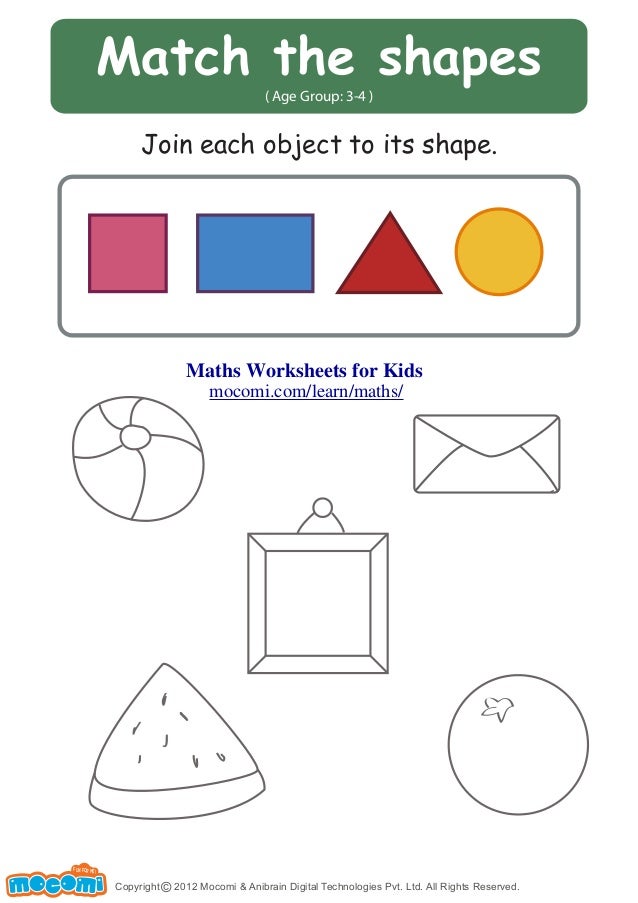 In fact, I have compiled my ten favorites into a collection of 2D Shapes Centers and Activities! These activities include practice opportunities for 12 different two-dimensional shapes. These shape centers are perfect for kindergarten, Pre-K, and preschool!
In fact, I have compiled my ten favorites into a collection of 2D Shapes Centers and Activities! These activities include practice opportunities for 12 different two-dimensional shapes. These shape centers are perfect for kindergarten, Pre-K, and preschool!
2D Shapes Centers and Activities
$5.00
These 2D shapes centers and activities are full of learning and fun for your preschool and kindergarten students. You can use these activities as you introduce the 2D shapes to your class, or spread them out throughout the year in your math centers. Some centers are also in black and white to be printed on colored paper.
Shop Now
Save These 2D Shape Activities
Be sure to save this post to your favorite classroom board on Pinterest so that you can refer back to these ideas later!
21 Creative Ways to Teach 2D Shapes in Kindergarten – KindergartenWorks
Teaching shapes to kindergarten is part of many standards-based curriculums.
When you teach 2D shapes, you're covering some basic geometry skills your kinders will build from for years to come.
Let's look at how to teach 2D shapes and dig into some 2d shape activities and games to help you cover this topic.
How to teach 2D shapes
If you're wondering how to teach shapes to kindergarten - then here are the essentials you need to cover.
1. Teach the names
Teach the names of the shapes. You could consider this vocabulary, but they need to identify the name of each shape no matter the orientation (which way the shape is turned).
source: teachwithme.comYou can always use a fun hook like these 2D shapes owl craft to get them started on learning the names of the shapes.
I recommend these 2D shapes kindergartners should know the best: circle, triangle, rectangle, square and hexagon.
source: miss-kindergarten.comYou could easily add some free shape posters or poems to your daily routine until your kiddos know them by heart.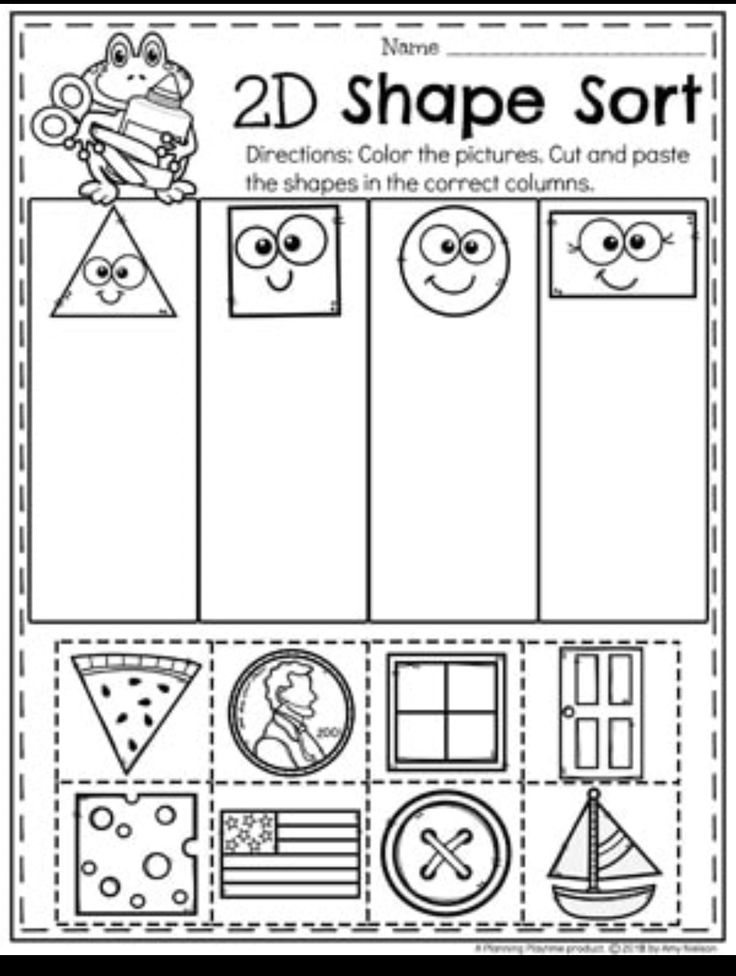
And this is totally my opinion - but forget teaching 2d shapes like the heart and the star (those are almost like "gimmes" in today's kindergarten).
Remember: if you use pattern blocks for any activities - don't shy away from teaching the trapezoid, rhombus and parallelogram. It's an easy way to get extra shape names with what you're already using.
2. Teach what makes a shape unique
Teach the unique characteristics of each shape. What makes the shape unique?
You can use 2D shape bingo, a hide-n-feel game or even a little mini booklet to help cover how to describe the 2D shapes.
I made a mini 2D shapes booklet to use with my guided math groups.
I like that students pick up on the basic book pattern:
- The first page asks a question based on a shape's attributes.
- The second page answers it.
But you can even create shape puppets to get them talking about what makes the shapes unique.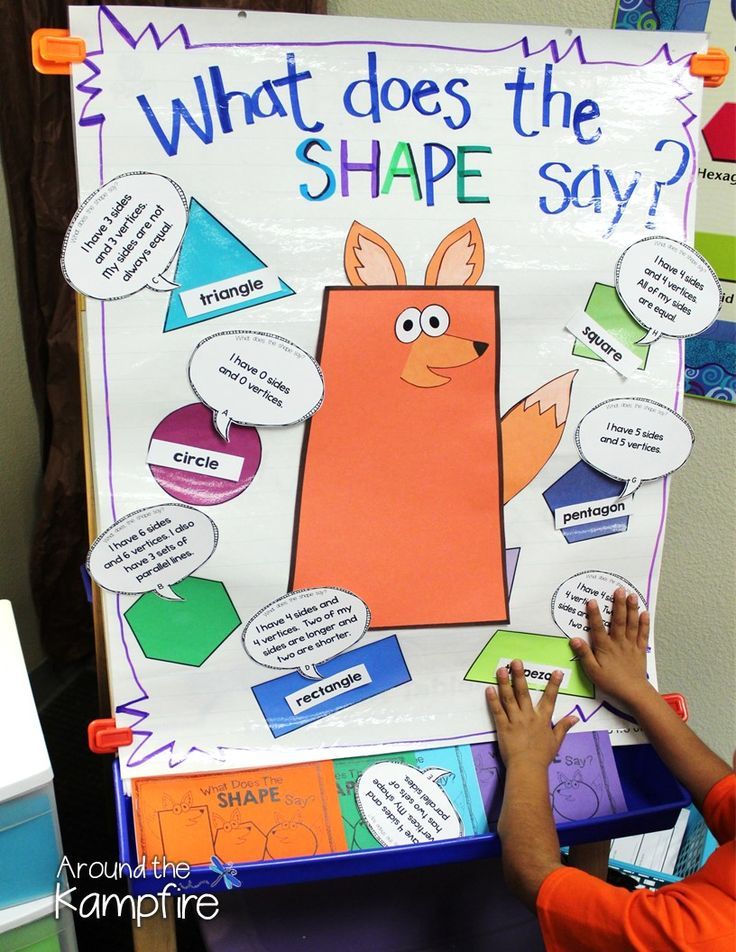
Consider using videos as well to teach describing 2D shapes - like how many sides and vertices each shapes has.
3. Teach what makes a 2D shape a 2D shape
Teach what makes the circle, square, triangle rectangle and hexagon all 2D shapes in a simplified fashion.
I like teaching this when I introduce 3D shapes (we compare the difference) and my students can already name and describe all of the 2D shapes for kindergarten accurately.
4. Teach shapes in the world
Teach real-life examples of shapes. Students should be able to pick out shapes in the world from the environment around them but also create real-world things by combining 2D shapes.
This quick shapes in the world video for kindergarten is perfect before going on a shape hunt.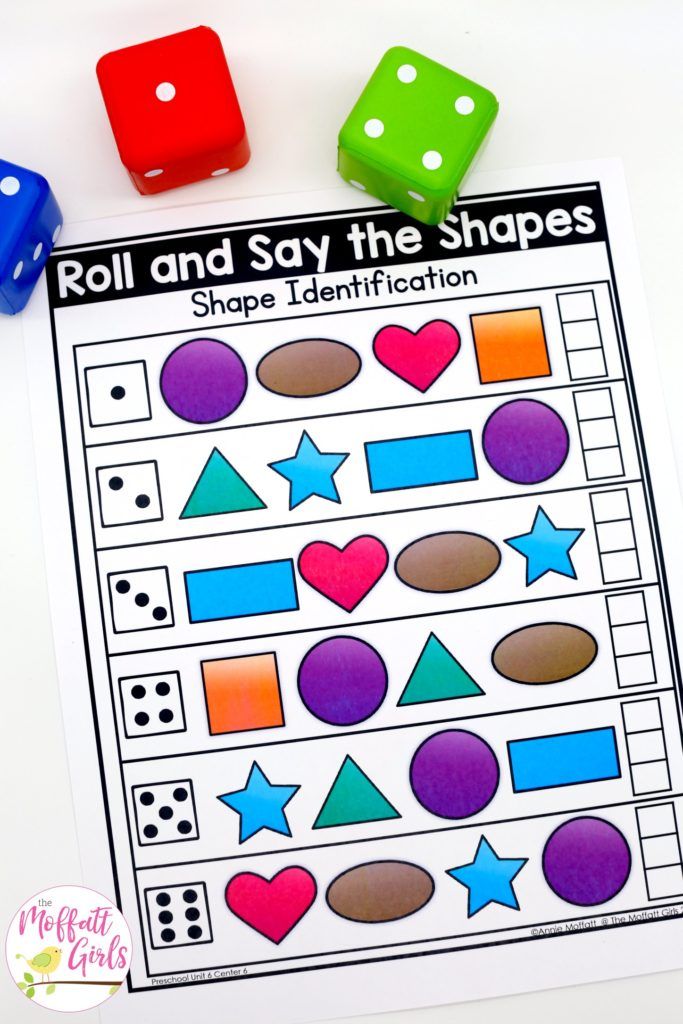 It reinforces a circle, square, and triangle in everyday items and has kids draw shapes in the air.
It reinforces a circle, square, and triangle in everyday items and has kids draw shapes in the air.
You'll find a few more examples of how to teach shapes in the world with some of the activities listed below.
Activities to do
Here are some fun ideas for how to teach 2D shapes with kinders.
There is a variety to pick from that can help accomplish the goals we mentioned above.
source: crayonbits.blogspot.comCreate a lift-the-flap riddle book with your students. Have them dictate the text and cut out shapes. Let them show what they know to make a class book.
Teach how to draw the shapes - by teaching how many points to draw. I learned this tip from our district's leading preschool teacher.
Kids that came from her preschool program came in knowing how to draw shapes in kindergarten and I learned this was her secret method of teaching them! {wink}
source: afaithfulattempt.blogspot.comIf you're teaching 2D shapes during Christmas, create a Rudolph at the window art project using construction paper shape pieces.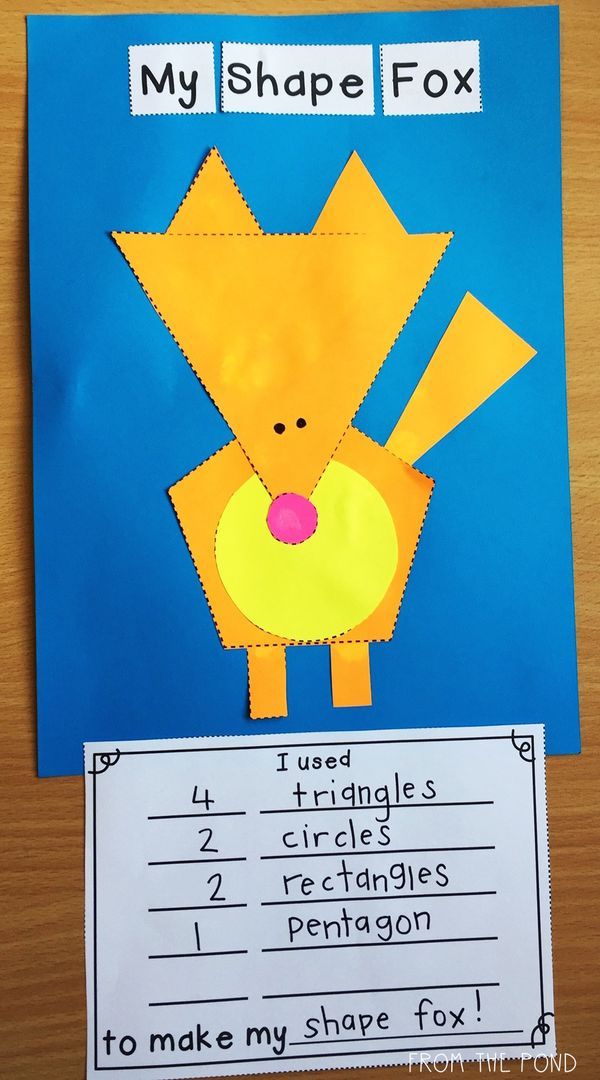 It sticks to basic shapes. I love the finished product.
It sticks to basic shapes. I love the finished product.
You could also use this free shape reindeer card activity and adapt it a bit since it was designed for first grade.
source: bishopsblackboard.blogspot.comTake the shape your class is having the most difficulty with and let them get creative! Have them turn the shape into something in our world simply by adding details.
source: peekaboomakelearnsewanddo.blogspot.com.esUse whatever shape manipulatives you have and create 2D shape scenes or real-world things. Snap photos with your phone and print them as example cards.
Students can try to recreate yours or build their own 2D shape real-world things.
If you only have pattern blocks, try to add in some circles, squares, and rectangles made out of craft foam from the dollar tree.
source: llittlefamilyfun.comSpeaking of making your own 2D shape manipulatives - this teaching 2D shapes dinosaur activity is a perfect example. Cut your own shapes and let your students create.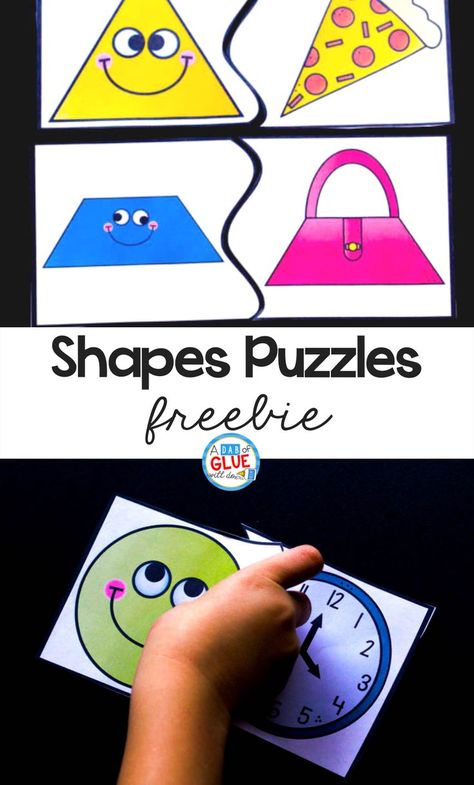
Grab toothpicks and marshmallows (or playdough) with these printable build a 2D shape cards. Students can focus on the number of vertices each shape has.
Play 2D shapes games
Play games that involve looking at shapes in different ways.
Play this little roll-a-shape 2D shapes in the world game. It's perfect for beginning kindergarten.
It's simple to play and students can do it independently. They roll a die, say the shape's name and color or trace a matching shape in the picture.
This shapes in the world printable board game is a simple way to play in small numbers.
source: downunderteacher.blogspot.com.auIf you just need something that works on naming and identifying - then this quick shape game is what you're looking for. Add a pencil and paper clip as a makeshift spinner.
I've found a way to turn bingo into a super-effective way to work on describing shapes in kindergarten. So check out this describing 2D shapes bingo game that is free.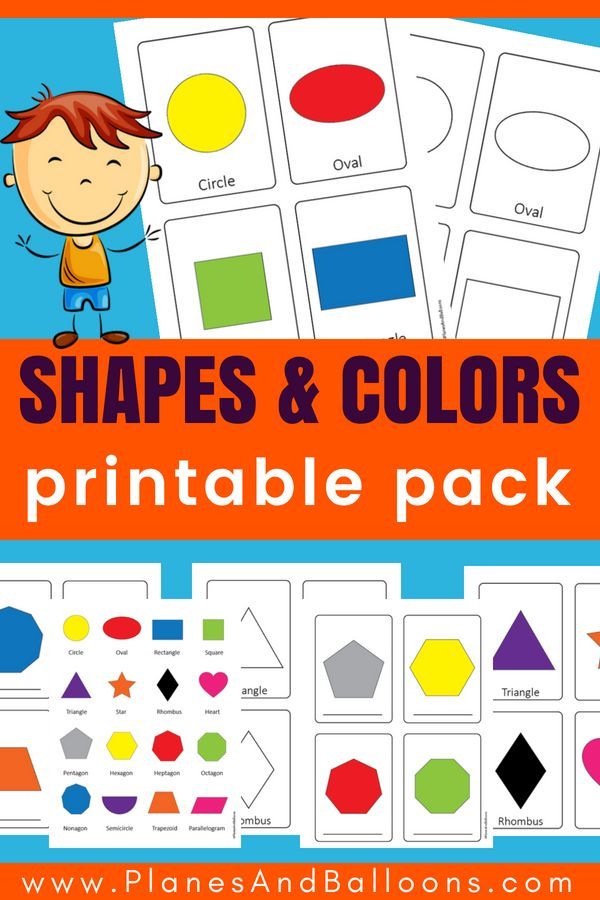
It's a classic game that's easy to share with parent volunteers too since they usually already know basic bingo rules.
source: firstgradealacarte.blogspot.comHere's an alternate naming shapes game that is styled after chutes and ladders. I think they'd like this format.
Go on a shape hunt around the classroom simply by following the directions in this secret agent shapes detective video.
Play what's hiding under the rug. This is the easiest game to teach and play with kindergarten. I love turning it over to pairs of students to play in our small group sessions so I can listen in on how accurately they are describing 2D shapes.
It's an ideal way to informally assess how well students are doing on this skill.
Let students each play at their own pace and graph their results with this 2D shapes game.
Find the shapes hidden in these landscapes to bring back color to the black-and-white pictures. This interactive, online shapes game reminds me of the old school Highlights for Kids magazines {wink}
Let's wrap it up
There you have the basics of how to teach 2D shapes and creative activities, games, and videos for teaching 2D shapes in kindergarten.
I hope you've found exactly what you need to complete your lesson plans. It's my goal to help you organize, think and teach your best.
You may also enjoy this short list of 2D shapes videos.
If you like what I do here on KindergartenWorks, then be sure to subscribe today. I look forward to sharing ideas with you weekly.
More Math in Kindergarten
- 10 Activities for Describing 3D Shapes in Kindergarten
- Monster Numbers – Easy Tools to Teach 0-10
- Making 5 Fluency Ideas and Games
Learning Geometric Shapes: Games for Preschoolers
One of the important aspects of the development of mathematical concepts in preschoolers is the study of the basics of geometry.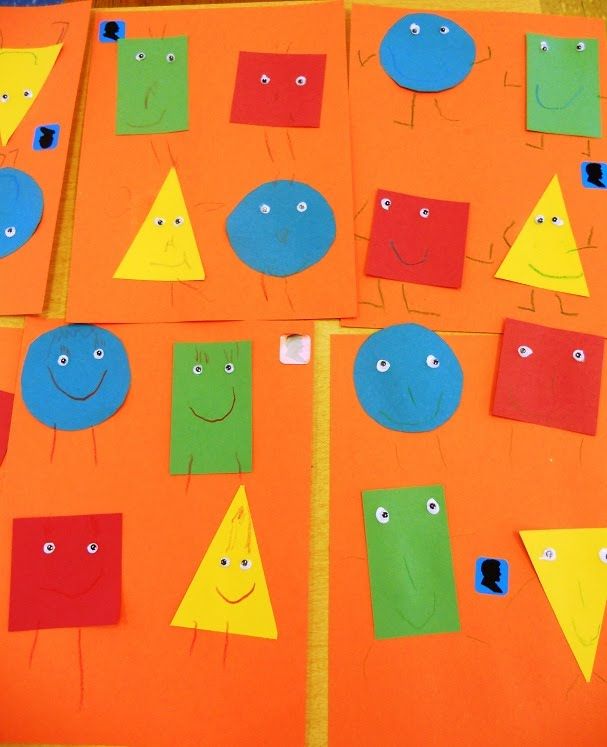 In the course of acquaintance with geometric shapes, the child acquires new knowledge about the properties of objects (shape) and develops logical thinking. In this article, we will talk about how to help a preschooler remember geometric shapes, how to properly organize games for teaching geometry, and what materials and aids can be used to develop a child’s mathematical abilities.
In the course of acquaintance with geometric shapes, the child acquires new knowledge about the properties of objects (shape) and develops logical thinking. In this article, we will talk about how to help a preschooler remember geometric shapes, how to properly organize games for teaching geometry, and what materials and aids can be used to develop a child’s mathematical abilities.
At what age can one start learning geometric shapes?
Many parents are wondering if young children need to get acquainted with geometric shapes. Experts believe that it is optimal to start classes in a playful, relaxed form from the age of 1.5. Until this age, it is appropriate to pronounce to the child the names of the shapes of objects that the baby meets in real life (for example, “round plate”, “square table”).
Introducing the child to geometric shapes, be guided by his reaction. If your baby started to show interest in them at an early age (by playing with the sorter or looking at pictures), encourage his curiosity.
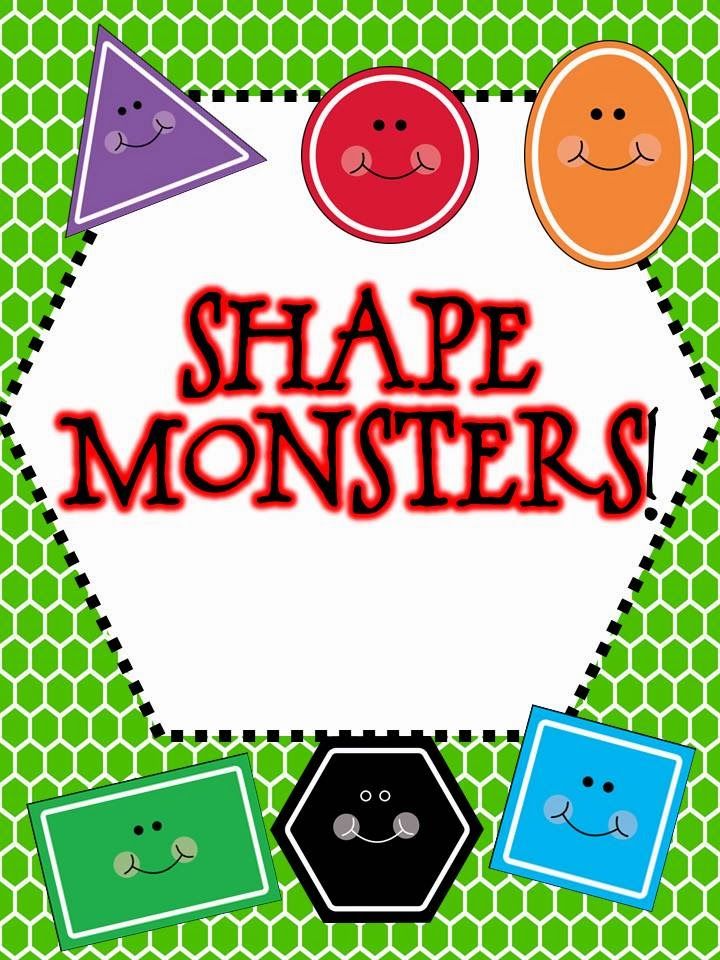
At the age of 2, the baby should be able to distinguish between:
- Circle;
- Square;
- Triangle.
By the age of 3 you can add:
- Oval;
- Rhombus;
- Rectangle.
At an older age, a child can memorize such shapes as a trapezoid, a pentagon, a hexagon, a star, a semicircle. Also, children visiting the Constellation Montessori Center get acquainted with geometric bodies with interest.
How can I help my child remember geometric shapes?
Teaching a child geometric shapes should take place in stages. You need to start new figures only after the baby remembers the previous ones. The circle is the simplest shape. Show your child round objects, feel them, let the baby run his finger over them. You can also make an application from circles, mold a circle from plasticine. The more sensations associated with the concept being studied, the child receives, the better the baby will remember it.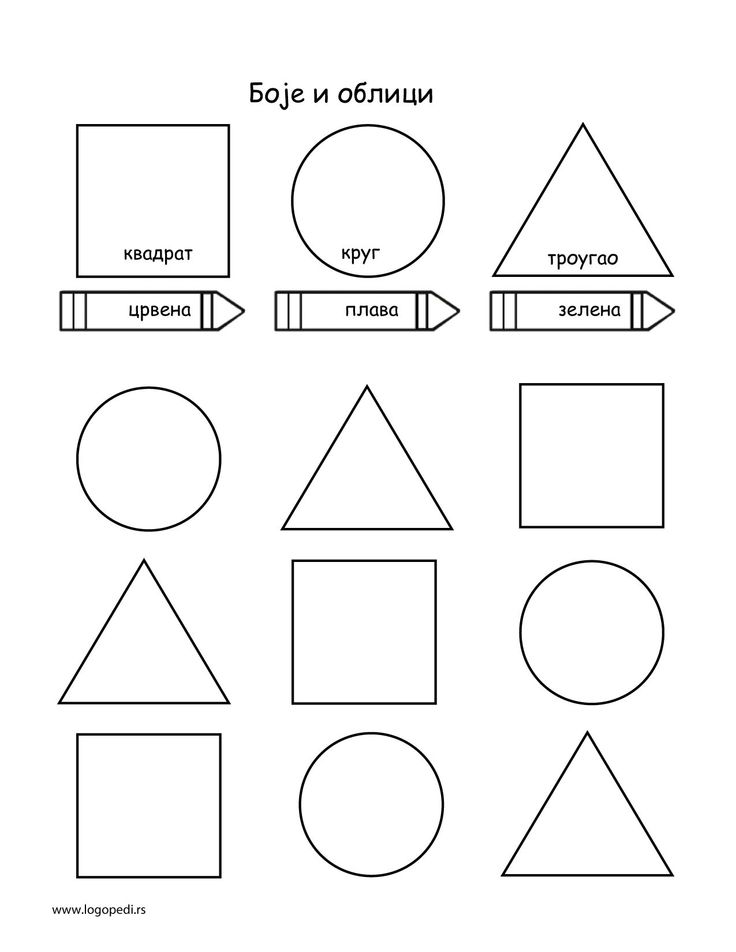
Three-dimensional figures can be used to get acquainted with the forms. It can be made by a designer, a sorter, lacing, frame inserts. Since at an early age the visual-effective type of thinking is most developed, various actions with figures will help to remember them better.
How children of different ages perceive geometric figures
The operations that a child can perform with geometric figures and how he perceives shapes depend on the age of the baby. In accordance with age characteristics, the following stages of training can be distinguished:
- In the second year of life, the baby is able to visually recognize familiar figures and sort objects according to shape.
- At 2 years old, a child can find the desired shape among a number of other geometric shapes.
- By the age of 3, babies can name shapes.
- At the age of 4, a child is able to correlate three-dimensional figures with a flat image.
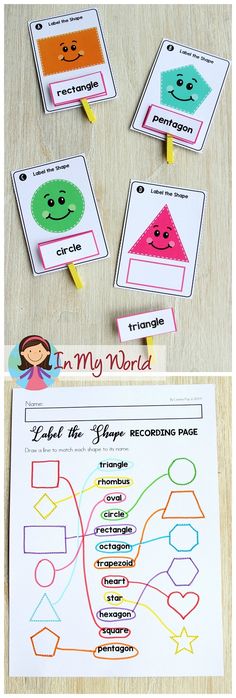
- At senior preschool age (and sometimes even earlier) you can start studying geometric bodies (ball, cube, pyramid). Also at this age, the child can analyze complex pictures consisting of many shapes.
Regardless of the child's age, try to pay attention to the shapes of the surrounding objects and compare them with known geometric shapes. This can be done at home and on the go.
Games for learning geometric shapes
For a child to be interested, learning geometric shapes should take place in a playful way. You should also select bright and colorful materials for classes (you can buy them in a store or do it yourself). Here are some examples of games and tutorials for learning geometric shapes:
- Sorting. Games with a sorter can be started from the age of 1. Invite the child to find its window for the figure. So the child will not only memorize geometric shapes, but also develop fine motor skills, thinking and spatial representations, because in order for the part to fall into the hole, you need to turn it at the right angle.
 You can also sort any other items, such as building blocks, Gyenesch blocks, or counting material.
You can also sort any other items, such as building blocks, Gyenesch blocks, or counting material. - Insert frames. In fact, this manual is similar to a sorter. For each geometric figure, you need to find its place.
- Geometric lotto. To play, you will need a field with the image of geometric shapes and handout cards with each figure separately. A child can take small cards out of a chest or bag, and then look for their place on the playing field. This game also perfectly trains the attention of the baby.
- Geometric appliqué. Cut out various geometric shapes from paper and, together with your child, make a picture out of them (for example, you can make a Christmas tree from triangles, a house from a square and a triangle).
- Drawing (including stencils).
- Modeling.
- Laying out figures from counting sticks.
- Geometric mosaic.
- Laces with geometric shapes.
- Card games.
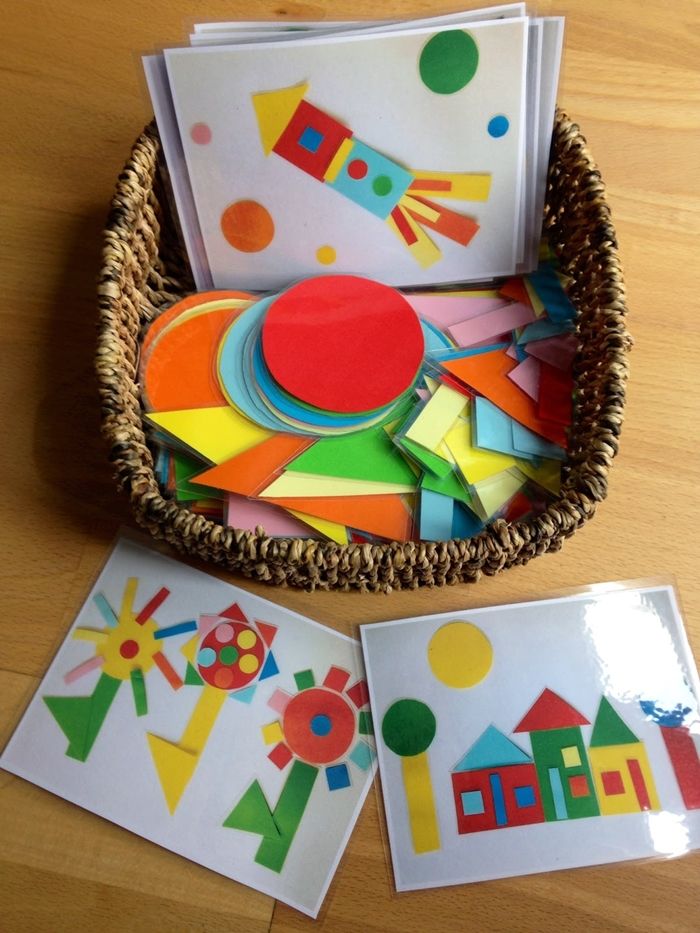
- Guess by touch.
- Active games. Draw geometric shapes on the pavement with chalk. Ask the child to imagine that the figures are houses that you need to run into on a signal. Next, you name a geometric figure, and the child runs to it.
In addition, educational cartoons can be used to study geometric shapes. Here is one of them:
Conclusions
Learning the basics of geometry at preschool age is an important part of developing a child's mathematical and sensory representations. Acquaintance with the figures should occur gradually (first, simple figures - a circle, a square, a triangle). To keep your child interested, study geometric shapes in a playful way. Your assistants in this can be such educational aids as insert frames, mosaics, lotto, sorters, sets of geometric shapes and bodies, stencils. You can also study geometric shapes on the street: just talk to your child about what you see around and what shapes these objects look like. Then the kid will definitely learn to distinguish geometric shapes and remember their names.
You can also study geometric shapes on the street: just talk to your child about what you see around and what shapes these objects look like. Then the kid will definitely learn to distinguish geometric shapes and remember their names.
Conclusion
Montessori environment has been specially created for the comprehensive and harmonious development of each child in the children's center "Constellation". In the process of free work in it, children not only get acquainted with the basics of geometry, but also develop their cognitive processes, fine motor skills, learn to write, read, and count. In addition, the Montessori environment gives the child the opportunity to fully demonstrate independence and responsibility. We will be glad to see you and your baby at our center!
Prepared by a Montessori teacher
Malysheva Evgenia
Easily and quickly learn geometric shapes with children
Why teach a small child geometric shapes? Surely, many parents do not even think about this issue, simply paying tribute to fashion and teaching mathematics to the baby almost from birth.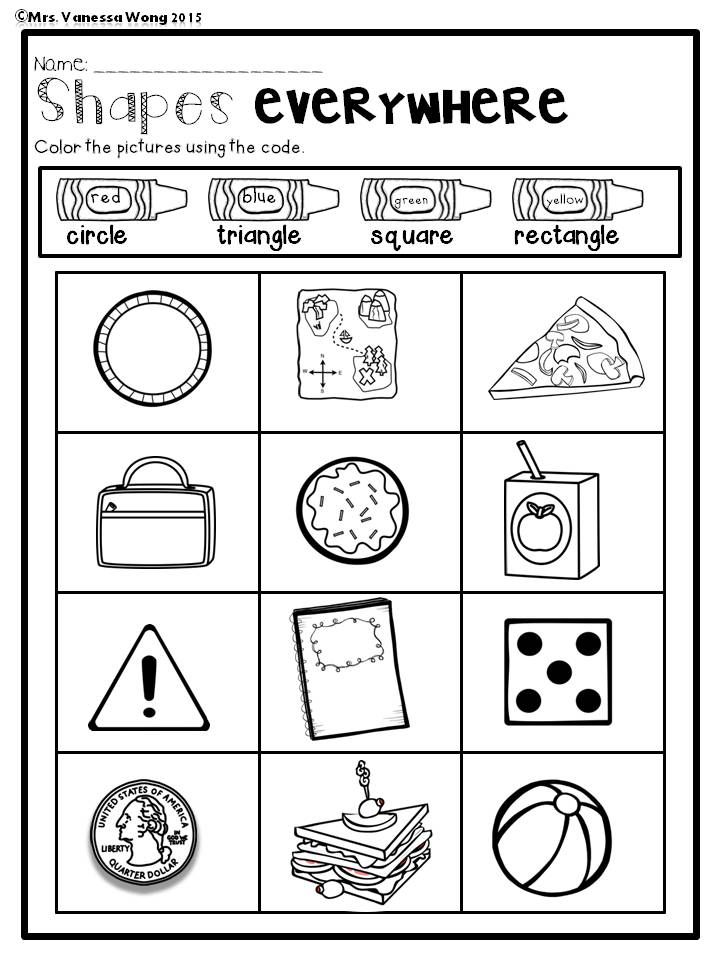 Meanwhile, geometric shapes for children, their timely study play a big role in the knowledge of the environment, introducing one of the main properties of objects - shape. This is necessary for the development of logical thinking, spatial representations, and the improvement of mathematical abilities. That is why it is important to start getting acquainted with geometric shapes as early as possible, reinforcing the knowledge of the children with exciting tasks in everyday life.
Meanwhile, geometric shapes for children, their timely study play a big role in the knowledge of the environment, introducing one of the main properties of objects - shape. This is necessary for the development of logical thinking, spatial representations, and the improvement of mathematical abilities. That is why it is important to start getting acquainted with geometric shapes as early as possible, reinforcing the knowledge of the children with exciting tasks in everyday life.
What a child should know about geometric shapes
Therefore, the home familiarization of the child with the forms should not take place separately, but in the system of sensory (sensual) education. Best of all, the baby will remember the shape when he simultaneously considers the color, size, purpose of the object, since knowledge is actively used in a variety of activities and is better remembered.
- Experts say that purposefully teaching a child geometric shapes at home should begin in the third year of life.
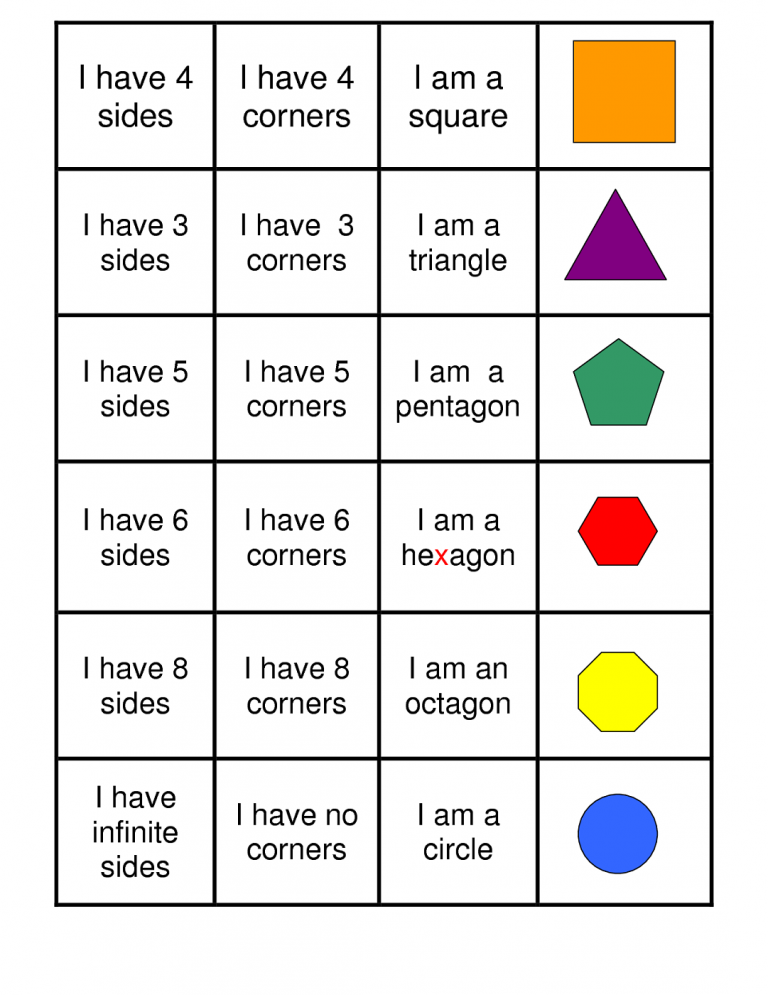 At this time, the children have a motor and tactile experience of studying the world around them. They know how to speak, they are distinguished by curiosity and the desire to explore everything, they strive for something new. That is why, for the further formation of knowledge in children, work is needed to replenish ideas about geometric shapes: a circle, a square, a triangle. In an exciting game (not on purpose!) the baby gets acquainted with the ball (ball), cube (cube).
At this time, the children have a motor and tactile experience of studying the world around them. They know how to speak, they are distinguished by curiosity and the desire to explore everything, they strive for something new. That is why, for the further formation of knowledge in children, work is needed to replenish ideas about geometric shapes: a circle, a square, a triangle. In an exciting game (not on purpose!) the baby gets acquainted with the ball (ball), cube (cube). - Four - five-year-old children, in addition to triangular, square, round shapes, recognize rectangular and oval. It is believed that at the age of 5 children already master geometry, therefore, by the next age stage, they must clearly name a circle, oval, triangle, square, rhombus, distinguish them and find them around them. Preschool children should be able to analyze and generalize the shape of objects, noting the main properties, and even solve logical problems by comparing shapes. For example, in the popular game "What are the similarities and differences between a circle and a square, a square and a rectangle, a circle and an oval?".
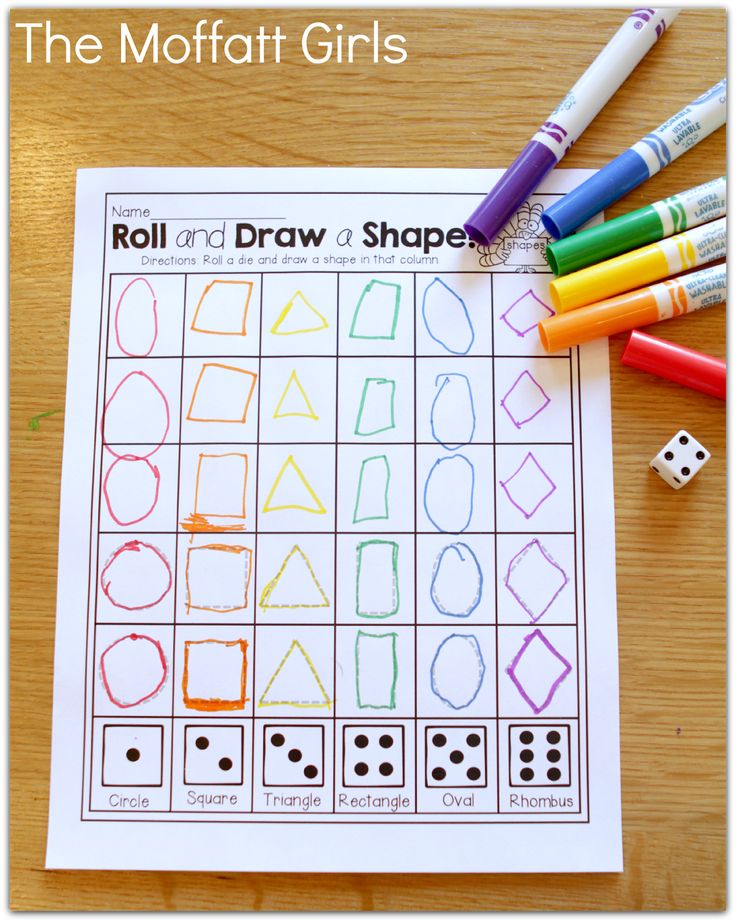
- Older preschool children already know the names of all the figures well, they are introduced to new ones: planar (polygon, trapezoid) and volumetric (ball, cube, cylinder and cone). For school education, children need to learn how to divide and assemble shapes in different ways (cutting and folding), solve problems - puzzles, for example, "Do you know how to make a square, rectangle, triangle out of two parts?", "How many squares (circles, rectangles ) on the image?".
Learning Geometric Shapes with Toddlers: Basic Rules
Important: How to teach a child to name and distinguish geometric shapes easily and quickly! To do this, you need to follow certain rules. With chaotic, inconsistent learning, the baby can confuse the figures, not see their similarity and difference.
- Teachers insist that the main rules for home schooling should be systematic, consistent, and accessible. It is not necessary to torture yourself and the child with any abstruse tasks and manuals, it is enough to use developing books, toys (designers, cubes, cars, doll utensils) and the familiar environment (furniture, household items, dishes).
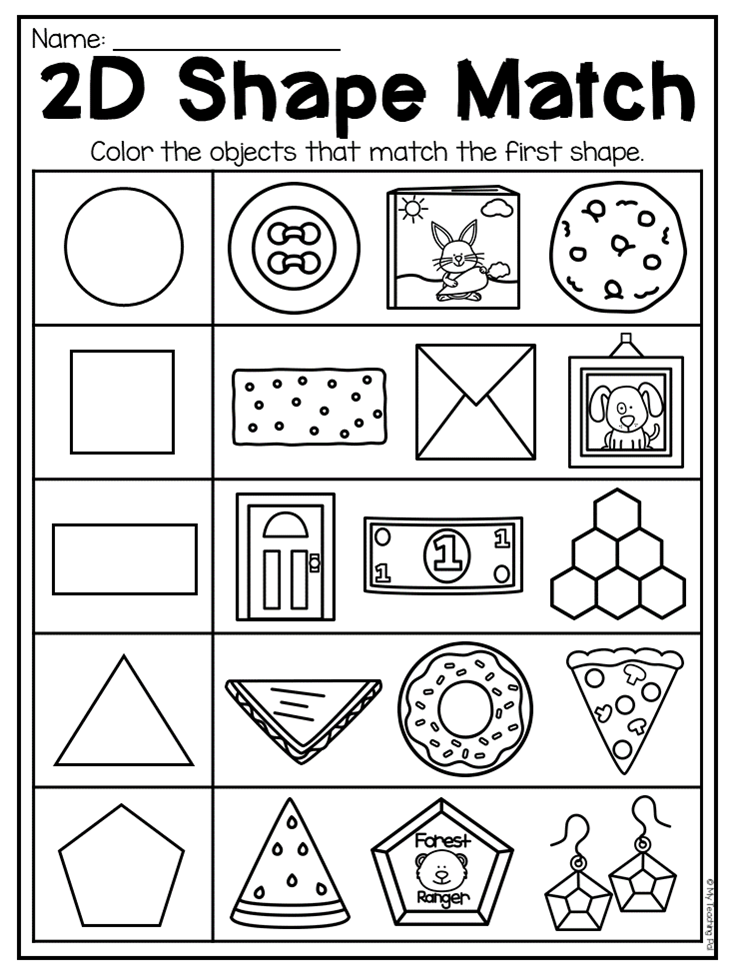
- Acquaintance with new figures must be carried out in research activities: invite the baby to feel, circle the contour with a finger, “draw” in the air, put the figures together, roll, stick them into the holes.
- A child will quickly master new material if he practically acts with it in games, creative activities, looking at and reading books, and household processes. For example, when introducing a baby to a square, you can invite him to find square objects in the environment: a seat by a highchair, a handkerchief, a face of a cube, a napkin. During a walk, ask what shape the bench in the park is, the wall of the house, mom's bag, the ball that the older guys play. At the same time, the adult himself clearly and clearly names all the geometric shapes that the baby encounters.
- It is good if adults use rhymes, fairy tales, riddles, cartoons, the heroes of which are geometric shapes, when teaching. You can not only read them, but also draw to the rhythm of the verse.
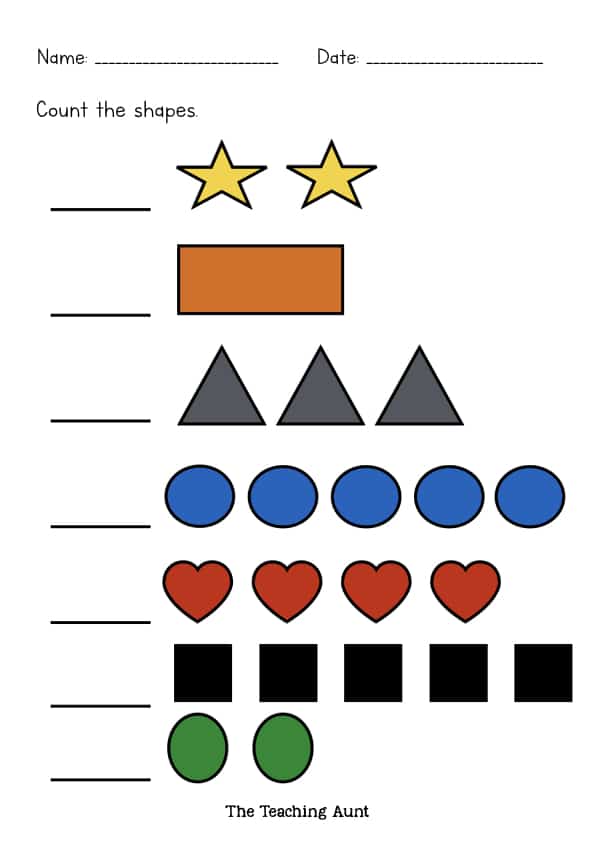 These techniques will make learning exciting, help to activate the processes of attention, thinking, speech.
These techniques will make learning exciting, help to activate the processes of attention, thinking, speech.
Riddles in verse
I have no corners and I look like a saucer, a plate and a lid, a ring and a wheel. Who am I, friends? Name me (circle).
He has been my friend for a long time, every corner in him is straight. All four sides are the same length. I am glad to present it to you. What is his name? (square).
Look at the figure and draw in the album, three angles, three sides connect with each other. It turned out not a square, but a beautiful one (triangle).
There is such a circle - a very strange appearance. The circle became flattened, it turned out suddenly (oval).
We stretched the square and presented it at a glance. Who did he look like or something very similar?
Neither brick nor triangle - became a square (rectangle).
Fairy tale "Two brothers" (an adult draws to the rhythm of the verse)
A long time ago in a dark forest in a figured hut there lived two brothers, two squares.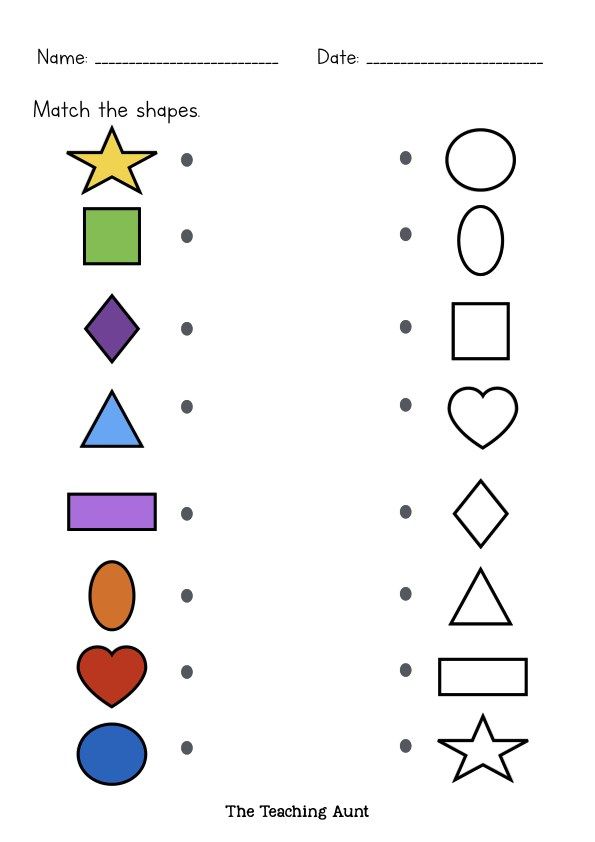 And they were twins. See for yourself:
And they were twins. See for yourself:
See in the picture - each has 4 sides, 4 corners and 4 tops.
Somehow the first square was walking among the bushes, knocking on the path with four corners.
And the animals say: “Who is this? The first square or its brother, the second square? How similar they are!
Remember in the picture: 4 sides, 4 corners and 4 tops.
The square is tired of being confused with his brother, and he decided to change, to turn into another figure.
He took scissors and cut off four corners for himself. Turned into a circle and rolled along the path.
And now the brothers live wonderfully, now it is difficult to confuse the brothers:
One rides along the paths, the other walks on four corners - four legs.
Two brothers are still friends - a circle with a square!
Important: Peculiarities of children's perception of geometric figures are not at all the same as in adults. For example, an adult sees objects according to their shapes (a saucepan is a cylinder, a window is a rectangle).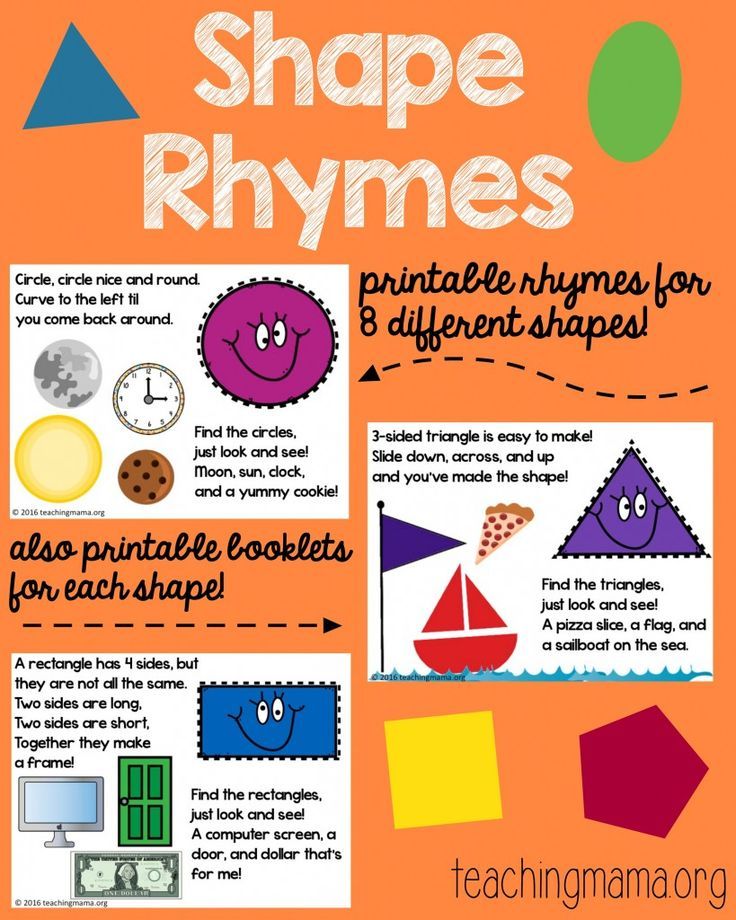 The child, on the contrary, first objects the shape (a square is a kite, a triangle is the roof of a house, a circle is a ball, several circles are glasses, beads). With proper training, he begins to abstract from objects and perceive a familiar figure in the environment, for example, a glass as a cylinder (cylindrical), a roof as a triangle (triangular), a ball as a ball (round).
The child, on the contrary, first objects the shape (a square is a kite, a triangle is the roof of a house, a circle is a ball, several circles are glasses, beads). With proper training, he begins to abstract from objects and perceive a familiar figure in the environment, for example, a glass as a cylinder (cylindrical), a roof as a triangle (triangular), a ball as a ball (round).
Playing with geometric shapes!
Teachers remind that preschoolers receive basic knowledge about geometric shapes in kindergarten, and homework is aimed at consolidating what they learn. Therefore, the best means at home will be the game, as the main activity of the kids. It is in the game that, unobtrusively, easily and quickly, the child will learn all the names of the figures, learn to compare and distinguish them. Among educational games for learning geometric shapes, board games are the most popular. They can be played in the evenings, during family leisure, made part of any home activity, entertainment.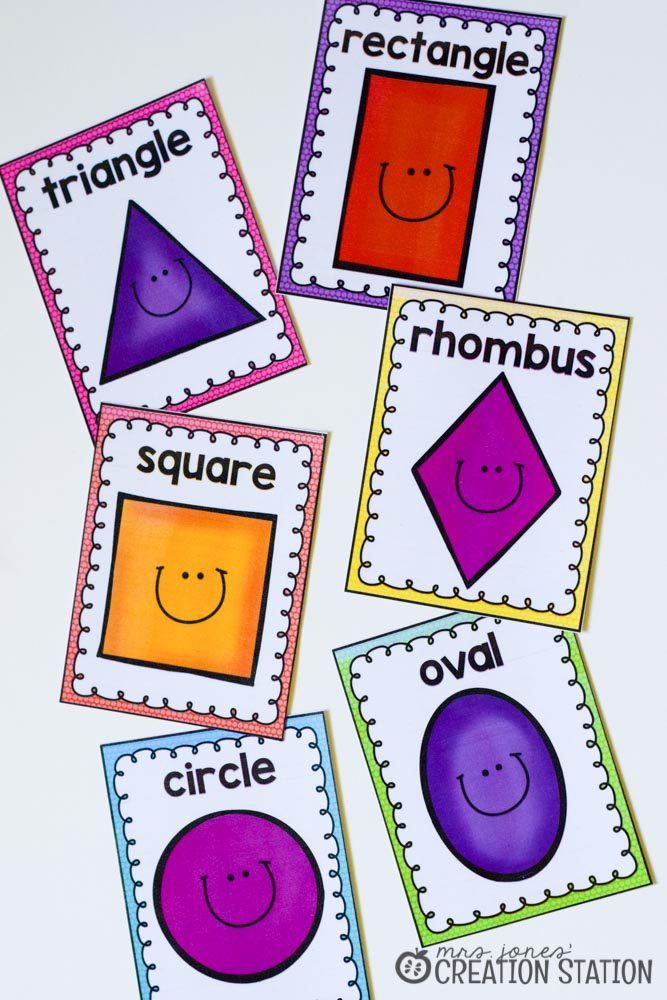
"What's hidden"
The classic game is understandable and accessible even to a two-year-old baby. An adult lays out images of familiar figures in front of the child: a circle, a square, a triangle. Since there must be at least five cards, figures of different colors and sizes are used for the quantity, for example, two squares - large and small, two triangles - blue and yellow, one circle. Consider them with the child, discuss, make sure that he understands what figures are in front of him and can name them correctly. Then the baby closes his eyes, the adult hides one of the figures and asks what is hidden. With age, the number of figures increases, new ones are added to the old ones.
“With one word”
The game "geometric figures" is aimed at developing in children a generalization of the same type of figures. An adult needs to prepare circles, squares and triangles of different sizes and colors. The preschooler must distribute the presented figures into groups, regardless of color and size, call them a generalizing word, for example, all squares.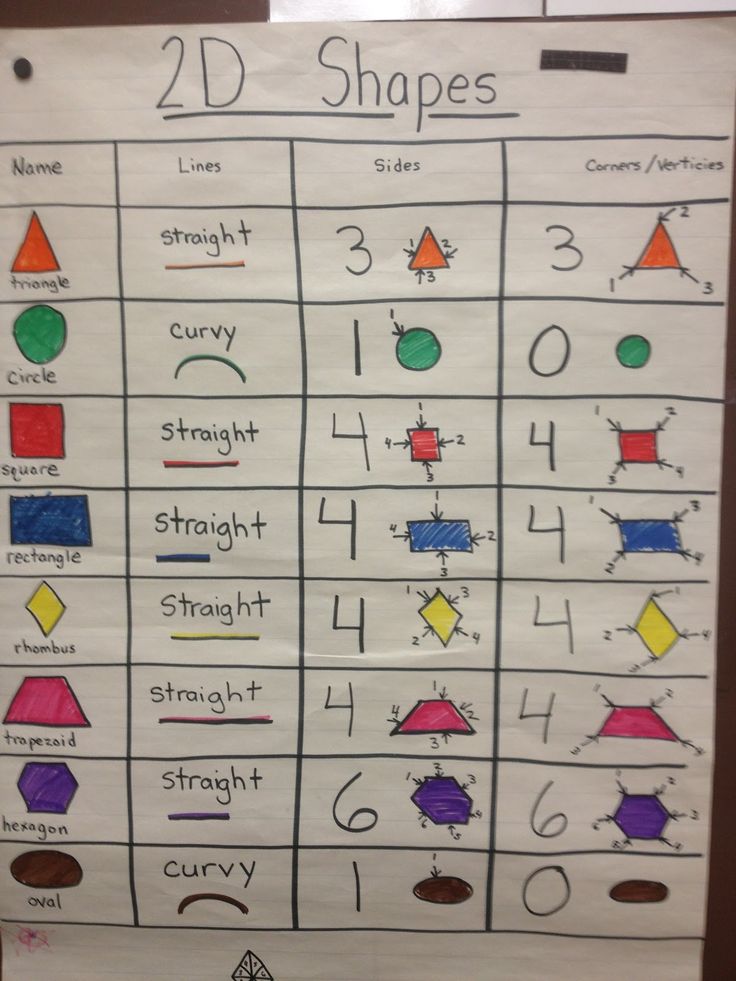 Alternatively, you can complicate tasks by offering to group shapes only by color or size.
Alternatively, you can complicate tasks by offering to group shapes only by color or size.
Wonder Pouch
Games like the "wonderful bag" are well known to children of kindergarten age. They are useful in that they give an idea of the contours of objects, teach examination by touch and exercise in distinguishing shapes. An adult prepares a bag with objects of various shapes, for example, a cube, a ball, a ball, a brick, a conical pyramid. The player examines them and names the shape of the toy they want to get. To complicate the task, older children are invited to find a specific form, for example, "Find a round toy."
“Magic Glasses”
Preliminary preparation of improvised glasses made of thick paper of various shapes: round, square. The game is interesting for all the guys, it helps to expand their understanding of geometric shapes, to find objects of a certain shape in the surrounding space. For example, a child puts on round glasses and looks for everything round around him: a plate, the bottom of a vase, a ceiling lamp by a chandelier, a carpet, grandmother's glasses.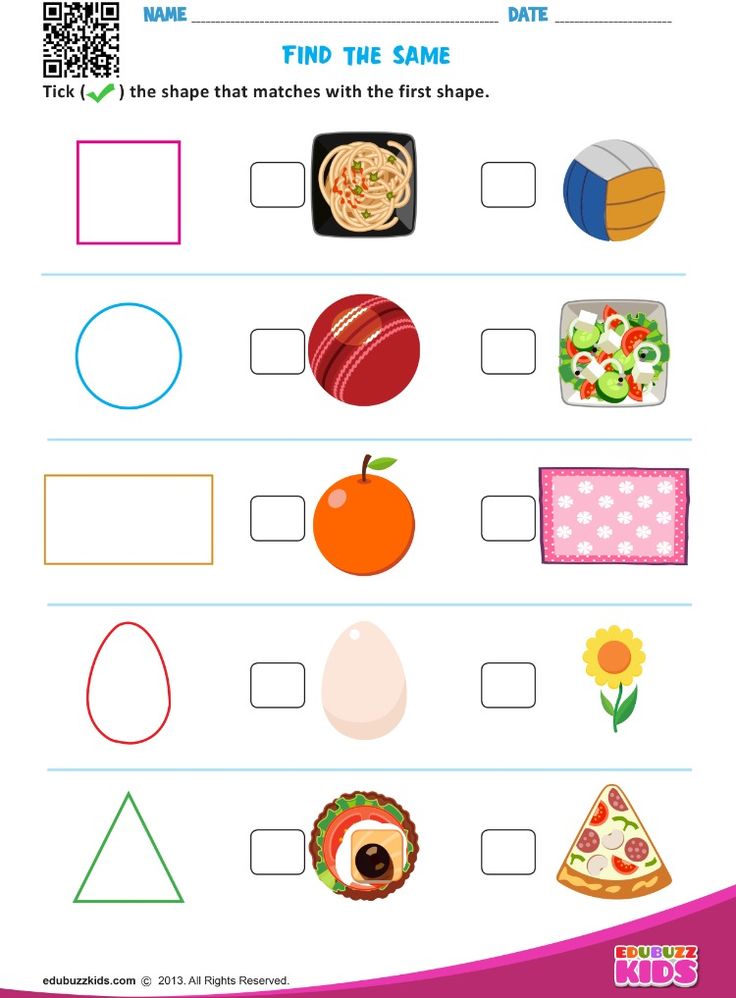 For each correct match, the player is awarded a chip, and then receives an incentive prize at the end of the game.
For each correct match, the player is awarded a chip, and then receives an incentive prize at the end of the game.
"Patches - patches"
For a lesson on fixing ideas about geometric shapes, you need a selection of pictures depicting various objects in which there are "holes" - unpainted places of different shapes, for example, a dress has a round hole, a boot has a square one. Among the different "patches" the child chooses the right one and connects it with the object. It will be interesting if an adult himself prepares images for the game, for example, cuts out things from paper (sweater, skirt, trousers, boots, hat). As a variant of the game of "patches - patches", you can purchase a didactic game of "Velcro", which are very similar in rules and content
“What's broken”
This task will help teach children to notice what form is missing in the depicted object, develops attention. For the game, you can use pictures, appliqué from cut out parts, building material.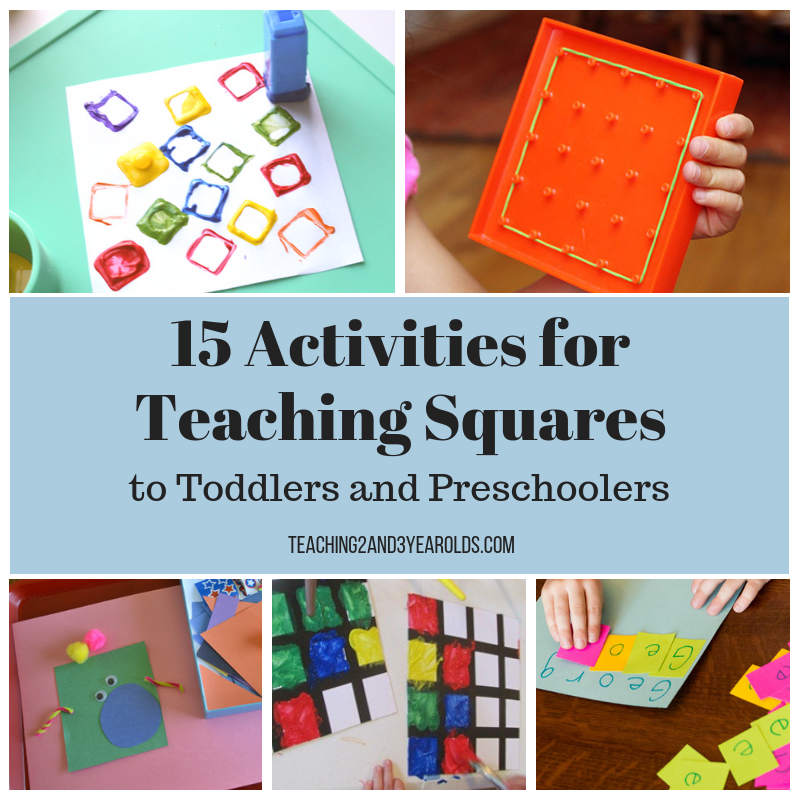 The main thing is that the object should consist of parts of a geometric shape. For example, an adult lays out the application "house", where the details are a triangle - a roof, a rectangle - a wall, a square - a window, a small rectangle - a door, a circle - a window in the attic, a quadrangle - a pipe. The child carefully examines the image and closes his eyes, the adult removes any detail, mixing it with any others. You need to guess what broke at the house and "fix" by finding the missing part. In the future, you can complicate the task by not immediately adding a certain form or removing two forms at the same time. If this is a drawn image, then the child paints on the missing details, for example, a circle is a wheel by a car, rectangles are windows by a turret.
The main thing is that the object should consist of parts of a geometric shape. For example, an adult lays out the application "house", where the details are a triangle - a roof, a rectangle - a wall, a square - a window, a small rectangle - a door, a circle - a window in the attic, a quadrangle - a pipe. The child carefully examines the image and closes his eyes, the adult removes any detail, mixing it with any others. You need to guess what broke at the house and "fix" by finding the missing part. In the future, you can complicate the task by not immediately adding a certain form or removing two forms at the same time. If this is a drawn image, then the child paints on the missing details, for example, a circle is a wheel by a car, rectangles are windows by a turret.
"Playing with sticks"
An interesting task for middle and older preschoolers, at the same time develops motor skills and the ability to make geometric shapes. If there are no counting sticks, you can use matches or toothpicks, prepare them first, cut off the sulfuric head or sharp ends so that the baby does not get hurt.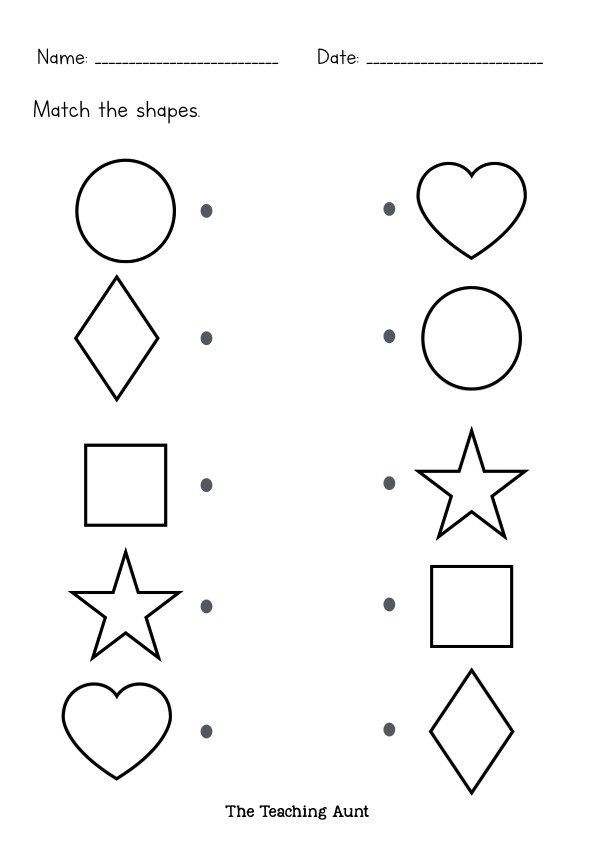 Such a task can be carried out in the form of a competition during family leisure, "who will make the figure the fastest?", "Who has the most difficult figure?". Then mark the winner with a prize. At some point, it must be a child. An adult, for example, may note his original solution or a carefully and accurately laid out figure.
Such a task can be carried out in the form of a competition during family leisure, "who will make the figure the fastest?", "Who has the most difficult figure?". Then mark the winner with a prize. At some point, it must be a child. An adult, for example, may note his original solution or a carefully and accurately laid out figure.
"What was useful to the artist in the picture"
For older preschoolers, you can use the original task of looking at pictures, which not only reinforces the name of the figures, but also develops visual perception, the ability to see different forms in an unusual setting. An adult selects illustrations of the appropriate content, which the artist draws using geometric shapes. Then he invites the preschooler to look at the picture and find familiar shapes. If any of them are still unfamiliar to a preschool child, be sure to pay attention to them and tell what they are called, what objects are similar to them. Complicating the game, you can calculate how many geometric shapes it took to depict the picture.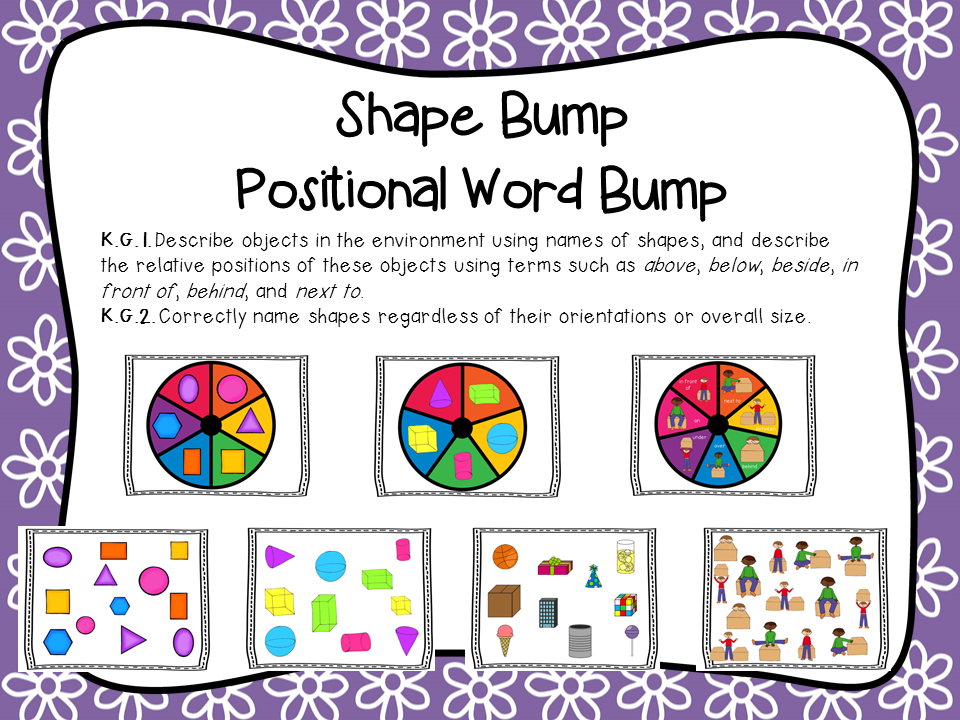
"Geometric Lotto"
A classic task for introducing children to geometric shapes teaches them to compare the shape of an object with a geometric figure, to select images based on a standard. To get a competitive moment, interesting for the kids, it is better to play with the whole family. The rule is classic: on large cards - images of different shapes, for example, an oval, a circle, a triangle. The facilitator says the name of the item on a small card, for example, an apple, a cucumber, a handkerchief, a TV. Players look for the shape of the named object on their card and cover it with the corresponding picture. The player who quickly and correctly closes the card wins.
"Geometric Mosaic"
Such an educational game will help children to consolidate their ideas about geometric shapes. In addition, it will teach preschoolers to transform them, focusing on the standard (sample), will help creative imagination. The rules of the game are simple and accessible to children of any age, for older ones - the number of details increases, the plots become more complicated.